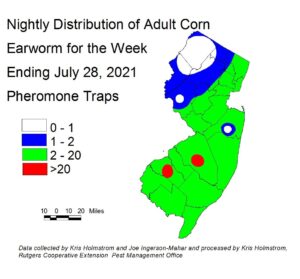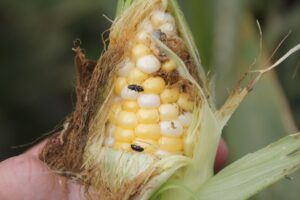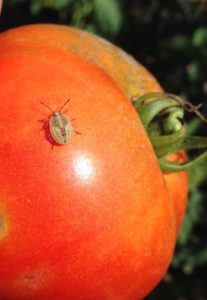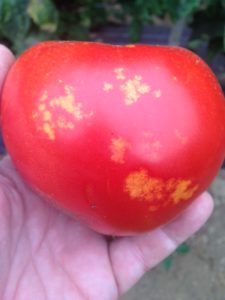Sweet Corn
European corn borer (ECB) moth catches continue to be extremely low around the state. ECB population maps will resume if second flight catches rise to high enough numbers.
The highest nightly trap catches of ECB for the week ending 07/28/21 are as follows:
| Crosswicks 1 |
| Matawan 1 |
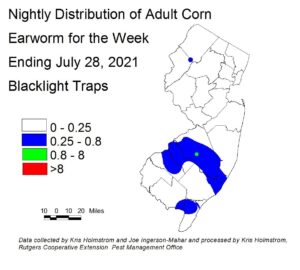 Corn earworm (CEW) moths captures from blacklight traps have declined further over the past week, as have pheromone trap captures, although pheromone numbers suggest tighter spray schedules in parts of the state. Elevated pheromone catches remain in the southern Burlington-Gloucester County region. North Carolina trap catches have are not indicating a substantive increase over the past week, and Delaware catches are in range with New Jersey. Generally we see our larger influx of CEW adults after the first week of August. Check this publication weekly for CEW status. The number of pheromone traps deployed is much lower, resulting in much broader color bands on the map. It is also important to understand that pheromone traps are more sensitive than blacklight traps, and thresholds are adjusted to account for the higher catches typical of this trap type. Silking corn is at risk of CEW infestation at this time. On the blacklight map (left), green areas represent a 3-4 day silk spray schedule and blue represents a 4-5 day schedule. On the pheromone map (below right), red represents a 3 day spray schedule, green represents a 4-5 day schedule, and blue represents a 5-6 day schedule. Be sure to access information from this publication in the upcoming weeks to determine how frequently you should treat silking sweet corn to protect it from CEW infestation.
Corn earworm (CEW) moths captures from blacklight traps have declined further over the past week, as have pheromone trap captures, although pheromone numbers suggest tighter spray schedules in parts of the state. Elevated pheromone catches remain in the southern Burlington-Gloucester County region. North Carolina trap catches have are not indicating a substantive increase over the past week, and Delaware catches are in range with New Jersey. Generally we see our larger influx of CEW adults after the first week of August. Check this publication weekly for CEW status. The number of pheromone traps deployed is much lower, resulting in much broader color bands on the map. It is also important to understand that pheromone traps are more sensitive than blacklight traps, and thresholds are adjusted to account for the higher catches typical of this trap type. Silking corn is at risk of CEW infestation at this time. On the blacklight map (left), green areas represent a 3-4 day silk spray schedule and blue represents a 4-5 day schedule. On the pheromone map (below right), red represents a 3 day spray schedule, green represents a 4-5 day schedule, and blue represents a 5-6 day schedule. Be sure to access information from this publication in the upcoming weeks to determine how frequently you should treat silking sweet corn to protect it from CEW infestation.
The highest nightly blacklight trap catches of CEW for the week ending 07/28/21 are as follows:
| Allamuchy 1 | Denville 1 | Jones Island 1 |
| Califon 1 | Downer 1 | Medford 1 |
| Cinnaminson 1 | Eldora 1 | Springdale 1 |
| Dayton 1 | Folsom 1 | Tabernacle 1 |
The highest nightly pheromone trap catches of CEW for the week ending 07/28/21 are as follows:
| Monroeville 35 | Green Creek 10 | Beckett 7 |
| Tabernacle 18 | Woodstown 10 | East Vineland 6 |
| Pedricktown 17 | Berlin 9 | Matawan 6 |
| Eldora 14 | Elm 9 | Dayton 4 |
Silking Spray Schedules*:
South – 3-4 days
Central – 4-5 days
North – 5-6 days
*These recommendations are based on regional catches. Adhere to tighter spray schedules if indicated by local trap catches. Synthetic pyrethroids alone should NOT be used for corn earworm (CEW) protection on silking corn, or for fall armyworm (FAW) management at any stage. Control with these materials is very inconsistent. Utilize materials in IRAC groups 5 and 28, or combination products that include IRAC group 28 for best control. See the Sweet Corn section of the 2020-21 Commercial Vegetable Production Guide for selections.
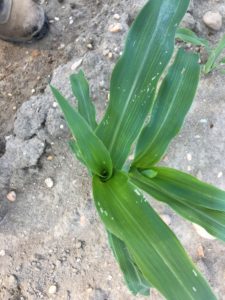
 Fall armyworm (FAW) larval infestations, while quite low, have been detected in all parts of the state. This is the time of the summer when FAW can show up, resulting in significant injury to whorl and even seedling stage corn. Injury from newly hatched larvae shows up as “window panes” or areas where leaf tissue has been eaten down the the lower epidermis (see photo at far left). This injury leads down into the whorl. As larvae gain size, they begin to consume leaf tissue in its’ entirety, creating ragged holes and lots of droppings (see photo at near left). FAW can be tough to manage because it is resistant to synthetic pyrethroid insecticides (IRAC 3A) and because larvae are often covered by their own droppings, making contact with the insecticide more difficult. Treat when 12% or more plants exhibit FAW injury alone, or in combination with ECB injury. As a rule, insecticides that are most effective on CEW will also adequately control FAW.
Fall armyworm (FAW) larval infestations, while quite low, have been detected in all parts of the state. This is the time of the summer when FAW can show up, resulting in significant injury to whorl and even seedling stage corn. Injury from newly hatched larvae shows up as “window panes” or areas where leaf tissue has been eaten down the the lower epidermis (see photo at far left). This injury leads down into the whorl. As larvae gain size, they begin to consume leaf tissue in its’ entirety, creating ragged holes and lots of droppings (see photo at near left). FAW can be tough to manage because it is resistant to synthetic pyrethroid insecticides (IRAC 3A) and because larvae are often covered by their own droppings, making contact with the insecticide more difficult. Treat when 12% or more plants exhibit FAW injury alone, or in combination with ECB injury. As a rule, insecticides that are most effective on CEW will also adequately control FAW.
Extremely hot days, very warm night temperatures and longer silk spray (5-6 day) intervals in much of the state have resulted in significant sap beetle infestations. These pests (photo at right) invade ears following insect or bird damage, but also when sustained high temperatures cause ears to exceed good husk cover. Materials used for CEW control, that will also manage sap beetles include synthetic pyrethroids (IRAC 3A (in combination with diamides IRAC 28)), methomyl (Lannate IRAC 1A), and acetamiprid (Assail, Anarchy IRAC 4A – must be combined with another recommended CEW material for CEW control). If husk cover is poor, and sap beetles are detected, it may be necessary to shorten the suggested silk spray interval by a day, using effective materials for both CEW and sap beetle while conditions affecting tip cover last.
Tomatoes
As we near the end of July, brown stink bug injury is increasing. These true bugs (see photo of Euschistus sp. nymph below at left), move into irrigated tomato fields as forage in the surrounding environment dries out. Feeding results in “cloudy spot” (see photo at right below). Increases in stink bug injury are often found by crews picking the fruit. Growers should consider 1-2 insecticide applications to limit fruit injury if this damage is increasing in harvested fruit. If actively scouting fields, insecticides should be considered if stink bug adults, nymphs or new fruit injury is found in 2 or more sample sites in a 10 site sample. Insecticides that are effective on stink bugs include pyrethroids and neonicotinoids, so care should be taken to avoid contact with foraging bees.

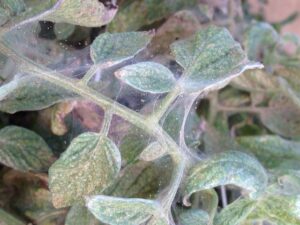 Two-spotted spider mite (TSSM) infestations are becoming more common in scouted tomato plantings. These pests multiply rapidly, and can cause severe defoliation under high temperature conditions if not detected early. Look for leaflets exhibiting pin spots (left) on the upper surface. These leaflets will become yellow as TSSM numbers increase. Mites may be observed on the underside of leaves showing these signs. Extreme infestations will result in extensive webbing being produced on top of foliage (right). Treatment should be undertaken when mites are first detected, because larger established infestations are quite difficult to control. Spot treatments may be effective if the infestation is limited. See the Tomato Section of the 2020-21 Commercial Veg. Recs. for details on effective materials.
Two-spotted spider mite (TSSM) infestations are becoming more common in scouted tomato plantings. These pests multiply rapidly, and can cause severe defoliation under high temperature conditions if not detected early. Look for leaflets exhibiting pin spots (left) on the upper surface. These leaflets will become yellow as TSSM numbers increase. Mites may be observed on the underside of leaves showing these signs. Extreme infestations will result in extensive webbing being produced on top of foliage (right). Treatment should be undertaken when mites are first detected, because larger established infestations are quite difficult to control. Spot treatments may be effective if the infestation is limited. See the Tomato Section of the 2020-21 Commercial Veg. Recs. for details on effective materials.
Southern blight has been found on a few farms in the scouting program this season. This fungal disease (Sclerotinia rolfsii) causes rapid wilting and death of plants. Inspection of the main stem at the soil line reveals the presence of numerous spherical structures (sclerotia) adhering to the stem (see photo at right – courtesy of Rhea Bolar). This disease is relatively uncommon in NJ, especially in northern counties, but exceptionally hot conditions with high soil moisture are contributing to it’s appearance. Little can be done once it appears. Tomatoes should be avoided in fields with a history of this disease. Future plantings may be treated with the PCNB fungicide, Blocker in the transplant water. See the Tomato Section of the 2020-21 Commercial Veg. Recs. for details.
Peppers
Pepper weevil – Traps are deployed, and we have still captured no weevils in pheromone traps. We are not aware of any fields having infestations. We normally find the most infestations in August. That we haven’t trapped any weevils is a good thing. A new fact sheet is now available for anyone interested in monitoring for pepper weevils on their own: FS1330: Monitoring and Management of Pepper Weevil in New Jersey (Rutgers NJAES).
Pumpkins and Winter Squash
Cucurbit downy mildew (CDM) is active on cucumbers in all parts of the state, and is infecting cantaloupes in southern NJ at this time. As yet, other cucurbits, including pumpkins, butternut squash, acorn squash and watermelons are unaffected. Recent wet weather favors CDM, and disease incidence on affected crops may worsen significantly under these conditions. For regional information on this important disease, see the Cucurbit Downy Mildew Forecast webpage: http://cdm.ipmpipe.org/. This forecast has NJ at low risk of further infection through Tuesday 7/27. Note however, that active infections will persist and increase locally with repeated rain and heavy dew events. It is advisable that all growers treat preventively for CDM on cucumbers and muskmelons. As yet, there have been no reports in the region of CDM affecting any other cucurbit crops. This is important, as pumpkins and winter squash are now active crops in the region.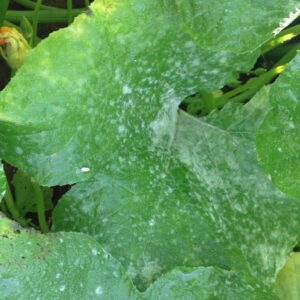
Early planted pumpkin fields in the scouting program are just now starting to develop powdery mildew (PM) lesions (right). It is expected that by next week, some of these fields will have exceeded the action threshold (2 lesions/100 older leaves) to initiate the powdery mildew fungicide program. For a list of effective materials and fungicide rotations, see the Pumpkin/Winter Squash section of the 2020-21 Commercial Veg. Recs.
Brown marmorated stink bug (BMSB)
BMSB trap catches remain very low. No map will appear in this addition.
